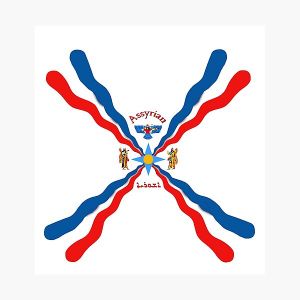Language/Assyrian-neo-aramaic/Grammar/Pronouns
Hi Assyrian Neo-Aramaic learners! 😊
In this lesson, we will focus on the pronouns in Assyrian Neo-Aramaic. Pronouns are a fundamental grammatical concept, so it's essential to master them to speak and write Assyrian Neo-Aramaic fluently.
Take some time to dive into these other pages after completing this lesson: How to Use "Be", Plurals & How to Use Have.
What are pronouns?[edit | edit source]
Before we dive into the specifics of Assyrian Neo-Aramaic pronouns, let's define what a pronoun is. A pronoun is a word that replaces a noun or a noun phrase. Using pronouns helps to make sentences less repetitive and more concise.
For example, instead of saying "John is the owner of the white car. John drives the car to work every day," you can say "John is the owner of the white car. He drives it to work every day." The pronouns "he" and "it" take the place of "John" and "car," respectively.
In Assyrian Neo-Aramaic, there are several types of pronouns, including personal, possessive, and demonstrative pronouns. Let's explore each type in detail.
Personal Pronouns[edit | edit source]
Personal pronouns indicate who is being referred to in a sentence. Assyrian Neo-Aramaic personal pronouns have the same forms for the subject and object, unlike in English, where there is a distinct form for each.
Below is a table showing the personal pronouns in Assyrian Neo-Aramaic, along with their pronunciation and English translation.
| Assyrian Neo-Aramaic | Pronunciation | English |
|---|---|---|
| ܐܢܐ | ana | I/me |
| ܐܢܬܐ | anta | you (masculine singular) |
| ܐܢܘܢ | anun | we/us (exclusive) |
| ܐܢܢܘܢ | annun | we/us (inclusive) |
| ܐܢܬܘܢ | antun | you (plural) |
| ܐܢܬܐܝ | antay | you (feminine singular) |
| ܐܠܐ | ala | he/him |
| ܐܠܟܐ | alka | she/her |
| ܐܠܝܢ | alen | they/them (masculine) |
| ܐܠܟܘܢ | alkon | they/them (feminine) |
Here is an example dialogue using personal pronouns:
- Person 1: ܐܢܐ ܕܐܬܘܪܝܐ. (Ana d-atoraya. - I am a teacher.)
- Person 2: ܐܢܐ ܐܬܐܪ. (Ana atara. - I am a student.)
Possessive Pronouns[edit | edit source]
Possessive pronouns indicate ownership or possession of something. In Assyrian Neo-Aramaic, the form of the possessive pronoun depends on the gender and number of the possessor and the possession.
Below is a table showing the possessive pronouns in Assyrian Neo-Aramaic, along with their pronunciation and English translation.
| Assyrian Neo-Aramaic | Pronunciation | English |
|---|---|---|
| ܥܕܝ | eddi | my/mine (singular masculine) |
| ܥܕܬܐ | edta | my/mine (singular feminine) |
| ܥܕܘܢ | edun | our/ours (exclusive) |
| ܥܕܘܢܢ | edunun | our/ours (inclusive) |
| ܥܕܬܘܢ | edtun | your/yours (plural) |
| ܥܕܘܢܝ | edunay | his/hers/its (singular) |
| ܥܕܐܝܢ | edayen | their/theirs (masculine) |
| ܥܕܟܝܢ | edkayen | their/theirs (feminine) |
Here is an example dialogue using possessive pronouns:
- Person 1: ܕܐܬܐܪ ܩܕܝܡ ܫܘܪܘܚܐ ܕܐܠܐ. (Atara qadim shurukha d-ala. - My car is old.)
- Person 2: ܥܕܘܢܝ ܩܕܝܡ ܫܘܪܘܚܐ. (Edunay qadim shurukha. - His/her/its car is old.)
Demonstrative Pronouns[edit | edit source]
Demonstrative pronouns point to a specific person, thing, or idea. In Assyrian Neo-Aramaic, there are two types of demonstrative pronouns: proximal and distal.
Proximal demonstrative pronouns refer to something close to the speaker or something that has been mentioned before, while distal demonstrative pronouns refer to something far or something that hasn't been mentioned before.
Below is a table showing the demonstrative pronouns in Assyrian Neo-Aramaic, along with their pronunciation and English translation.
| Assyrian Neo-Aramaic | Pronunciation | English |
|---|---|---|
| ܗܘ | hu | this/these (proximal) |
| ܐܗܘܢ | ahun | that/those (distal masculine) |
| ܗܘܝ | huy | that/those (distal feminine) |
Here is an example dialogue using demonstrative pronouns:
- Person 1: ܗܘܝ ܣܘܪܝܐ ܝܥܩܘܒ. (Huy surya ya'qub. - That book is Jacob's.)
- Person 2: ܗܘ ܣܘܪܝܐ ܕܐܬܘܪܝܐ. (Hu surya d-atoraya. - This book is a teacher's.)
Now that we've covered the three main types of pronouns in Assyrian Neo-Aramaic, it's time to practice using them! Try forming your own sentences and using pronouns to make them more concise and effective. To improve your Assyrian Neo-Aramaic Grammar, you can also use the Polyglot Club website. Find native speakers and ask them any questions!
➡ If you have any questions, please ask them in the comments section below.
➡ Feel free to edit this wiki page if you think it can be improved. 😎

